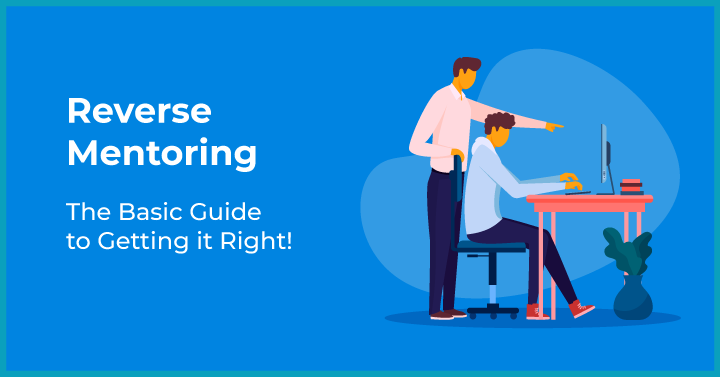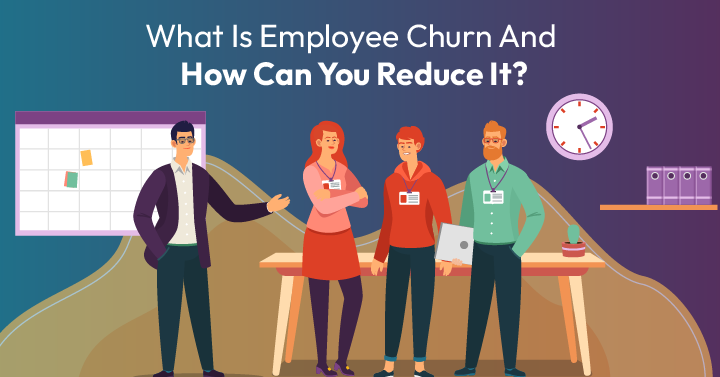
Mentoring, shepherding, guiding- whatever term you wish to call it, we’ve all had someone show us the ropes. And when someone says mentoring, we think of someone much older and more experienced than us. But, what if that someone was junior to you, by age, experience, competence, or all three? That’s reverse mentoring, in a nutshell.
I first came across the term in a Forbes article back in 2018 and was duly intrigued. Reverse mentoring was an experiment. In the late 90s, Jack Welch, General Electric’s CEO paired younger employees with executive team members. His intent was two-fold; to bring the older generation up to speed on using the Internet and technologies of that time, and to establish a connection with the junior hires.
In this blog, I’ll look at what reverse mentoring entails and what lies in store for it in the future. How will present-day millennials and the generation after them take to reverse mentoring? Keep reading to find out!

What is reverse mentoring?
Reverse mentoring is the concept of flipping the teacher and student roles in an organization. It is a symbiotic, learning experience for both the younger and older executives in a firm. Reverse mentoring educates seasoned members of the workforce on cultural relevance while breaking down the hierarchical barriers of age and seniority.
Modern reverse mentoring programs go beyond sharing one’s knowledge of technology. It's about altering your mindset and approach when dealing with a focus group whose interests, are drastically different from yours. Take AXA’s experience for example. Launched by Karima Silvent in 2014 in order to open a channel for employees to ask questions, the reverse mentoring program had a 97% satisfaction rate. A pair comprising both mentee and mentor said that curiosity and enthusiasm as critical success factors for reverse mentoring to work.
So, how does a mentor who works in a different department several levels below a mentee make learning a clash of ego? Let us look at a few benefits of reverse mentoring.
Benefits of reverse mentoring
Jack Welch gets credit for introducing the concept to his organization. Since then, dozens of esteemed companies have experimented with a reverse mentoring program structure with a clear purpose in mind on the expected outcomes. Some of the benefits of launching such a program include;
- Diversity and inclusion:
Reverse mentoring breaks down communication barriers. It treats everyone fairly and gives equal opportunities to all to ask questions, demonstrate their knowledge and even make a new friend! In fact, many mentors and mentees check back in with each other even after the program finishes, due to the rapport built while working together.
- Cultivates trust and empowers capabilities:
Entrusting the responsibility of showing the ropes to a junior employee lifts morale and boosts confidence in one’s own capabilities. Rather than reinforce the ideology that the older you are the more likely you are to be an authority on everything, it encourages a culture where no one is too old to learn something new! .
- Keeps everyone on the same page:
Millennials and Generation Z workers have the advantage of growing up in the midst of a technology boom. As such, they take to new and changing technologies more quickly. If anything, they can bring back the enjoyment quotient and teach executives to get comfortable with leveraging social media, business analytics and decision-making tools. All this, without the need for formal and structured training!
- Gives a fresh and different perspective:
Senior executives who are stumped by an existing bottleneck can get a cultural, technological or strategic perspective from someone younger or more junior to them. A junior or inexperienced recruit would know what helps consumers or an audience of their own age group relate to a business and can accordingly help businesses strategize and improvise on how to market themselves.
- Equips mentors with leadership skills:
Role-reversal and help junior (and possibly shy or introverted) employees fine-tune their leadership skills in different situations. It also helps develop empathy for the challenges a senior manager’s role entails and allows them to diffuse conflicts, cultivate negotiation skills and make tough decision calls.
Improves collaboration:
Getting to learn more about the viewpoints of another person can deepen your understanding of the values they uphold. It lets you find common ground and helps you put aside any differences, thus strengthening relationships that come in useful when collaborating in future.- Career Boost and References:
A junior mentor can climb up the career ladder based on a good word put in for them by the person they mentored. This is based on the fact that they would have interacted closely during the reverse mentoring partnership and can give honest feedback on your strengths and what makes you a suitable candidate for filling in an internal and more senior vacancy when the opportunity presents itself.
Disadvantages of Reverse Mentoring
As with any new initiative launch, reverse mentoring may invite a few raised eyebrows. It can easily be misconstrued as forcing employees who have been around a lot longer to do as instructed by someone much younger to them or new to the firm.
It needs to be handled so as to not offend long-time workers who might view someone junior assigned to mentor them as an indication that they are either a) Not doing a good job or b) are going to be replaced. Some challenges associated with reversing the mentee and mentor roles include
- Resentment to either the mentor or the business, which can potentially later lead to disinterest in work.
- Resistance to learning from someone younger and less experienced in handling a situation.
- Conflicts in a pairing up arising out of the refusal to meet in the middle.
- Fear of too many changes happening too fast, and without prior intimation of its purpose.
- Inadequate resources to support reverse mentoring programs.
The first step before implementing any role reversal is to inform and involve your workforce. While this may seem rather obvious, what happens often is that executives get caught up in the excitement of having a plan to re-engage their employees but forget who to include. Whether they are all in the same location or distributed in different ones, it is imperative that they know why this is being done.
Invite them to leave feedback in a Q and A or AMA (Ask Me Anything) session beforehand. This lets you take the temperature of the room and assess the general sentiment. You can then give teams a take-home quiz on their interests. As a next step, match and assign partners that closely match the answers entered in the quiz. This ensures that those who are pairing up are likely to get along with each other and can work together.
The next step is to determine whether a formal or informal setting is the way to go. You can accordingly acquire resources (in terms of rooms, timings, and even activity-based equipment) to give to those selected for such programs.

Reverse Mentoring Examples
A few famous case studies of reverse mentoring being successful include GE, AXA, BNY Mellon Pershing, Target, Cisco, UnitedHealthcare, and Fidelity. Although the scale and scope of it would vary, there’s one thing all reverse mentoring programs have in common. That is, the goal to unite their workforce and have them work together in harmony on projects that align with the values and mission statement of the company.
The learning is aimed at helping both the older and younger generation develop mutual respect for each other's opinions and insights and making these widely accessible.

How do I Set up a Reverse Mentoring Program?
The biggest hurdle in a reverse mentoring program is getting people excited about it. After all, we’re swapping mentor and mentee roles here which can take some getting used to. If you’ve watched the movie Freaky Friday starring Lindsay Lohan and Jamie Lee Curtis, you’ll know what I am talking about. As entertaining as the movie was, there was an important lesson learned; sometimes switching places can help you see where the other person is coming from.
Here are some steps you can take to set up your reverse mentoring program;
- Read the room
Observe how your team works solo and together to assess the dynamics. It's also an opportunity to see individual skills at play, and how people help each other out.
- Identify skills that benefit from reverse mentoring
Draw up a list of skills (technical, social and problem solving) that merit being taught in learning pods. Navigating social media, for instance, does not require formal classroom style training and can be scheduled at a time convenient to the participants.
- Plan in advance
Any mentoring and learning program requires you to plan ahead so that the timings and accessibility do not impact business-as-usual. Your participants shouldn’t feel pressured to learn and overwork themselves. The reverse mentoring program should be scheduled after factoring in existing workloads. Advanced planning confirms the bandwidth available.
Reverse Mentoring Questions
- What are the 3 A’s of Reverse mentoring?
The 3 important As of reverse mentoring are a) the mentor, b) the mentee and c) the relationship.
- Is there an age limit to participate?
There’s no age limit so long as both parties are employed at the same place of business. In fact, anyone from any department can crossover.
- Does reverse mentoring require a contract?
It depends on the kind of skills-building activity taking place. A contract formalises the relationship and gets participants into the mindset needed to teach, and learn.
- Where will you do this?
The ideal place is within a designated meeting or conference room with no other distractions. You should have access to whiteboards, internet and equipment or props.
- Can reverse mentoring be done remotely?
Reverse mentoring can be conducted online through virtual conferencing platforms. You just need to have a stable connection so that audio and video quality are optimal.
- I am not finding the program useful. Can I opt out?
If there’s a contract in place, you will need to read the terms to see if there’s a clause for opting out. You should also state reasons clearly in order to provide accurate feedback to both the mentor and program facilitator as to what was missing, or not up to the expectation.
- Can I request for another mentor or mentee?
Sometimes, a match on paper may not always work out practically due to conflicting personalities. In such cases, a written request to the program facilitator can be made to arrange for a swap based on availability.
Reverse Mentoring Framework
The reverse mentoring framework is as follows
- Run compatibility tests
Have mentors and mentees interact informally before the actual session to see how they get along. Give them team building activities to see how well pairs work together.
- Regularize meetups
Finalize how many times, where and for what purposes you’ll need to meet up.
- Prepare and agree to the ground rules
Set housekeeping rules to maintain a code of conduct which all mentors and mentees should follow.
- Establish shared goals
Reach a consensus on the outcomes to be achieved post completion of the reverse mentoring program.
- Define action steps
Roadmap the journey from start to finish to make it easier to review progress.
- Brainstorm for new approaches
Always keep an open mind to fresh perspectives.
- Review previous sessions
Sum up previous sessions before beginning a new one so that its easier to catch up.
- Ask for feedback
Collect feedback from both the mentee and mentor. Their input can not only help you measure the success of your mentoring program but can also be a tool to help improve future such programs.
What is the future of reverse mentoring?
How are people perceiving reverse mentoring now, and will this perception change down the line?
The truth is we’re all inclined to stereotype.
The older generation is too rigid, the younger generation is impudent and entitled, and so on. Reverse mentoring offers the opportunity to break down such stereotypes. It teaches one to not cement their judgment on a fleeting impression or heresy. Instead, it encourages you to openly interact and give your feedback. More importantly, it enriches a company by helping nurture tomorrow’s leaders. They acquire skills to steer the company in the right direction. They can move up in the organization based on a combination of insight-led mentoring and one’s own experiences.
Often, the challenge lies in having a great idea but lacking ways to market it and catch the attention of a different generation. This is more evident during hiring. The quest for new talent means that you’d need to talk up your organization’s perks and work environment in a way that not only sets expectations but also lets great talent make you their choice. A positive rating from teams that have been paired up on reverse mentoring programs can go a long way in helping your company grab the spotlight on review platforms, such as Glassdoor and Indeed.
 Interested in Virtual Team Building Events?
Interested in Virtual Team Building Events?




















